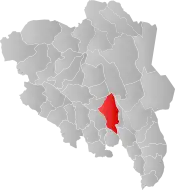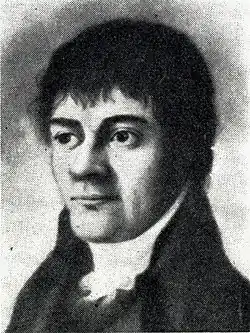Ringsaker
![]() Ringsaker is a municipality in Innlandet county, Norway. It is part of the traditional region of Hedmarken. The administrative centre of the municipality is the city of Brumunddal.
Ringsaker is a municipality in Innlandet county, Norway. It is part of the traditional region of Hedmarken. The administrative centre of the municipality is the city of Brumunddal.
Ringsaker kommune | |
|---|---|
 Lake Mjøsa in Ringsaker | |
 Coat of arms  Innlandet within Norway | |
 Ringsaker within Innlandet | |
| Coordinates: 61°1′27″N 10°48′7″E | |
| Country | Norway |
| County | Innlandet |
| District | Hedmarken |
| Administrative centre | Brumunddal |
| Government | |
| • Mayor (2007) | Anita Ihle Steen (Ap) |
| Area | |
| • Total | 1,281 km2 (495 sq mi) |
| • Land | 1,123 km2 (434 sq mi) |
| Area rank | 72 in Norway |
| Population (2004) | |
| • Total | 31,732 |
| • Rank | 23 in Norway |
| • Density | 28/km2 (70/sq mi) |
| • Change (10 years) | 1.2% |
| Demonym(s) | Ringsaksokning[1] |
| Time zone | UTC+01:00 (CET) |
| • Summer (DST) | UTC+02:00 (CEST) |
| ISO 3166 code | NO-3411 |
| Official language form | Bokmål[2] |
| Website | www |
The municipality of Ringsaker was established on 1 January 1838 (see formannskapsdistrikt). The municipalities of Furnes and Nes were merged with Ringsaker on 1 January 1964.
General information
Name
The municipality (originally the parish) is named after the old Ringsaker farm (Old Norse: Ringisakr), since the first church was built there. The first element is the genitive case of ringir or ringi, of unknown meaning. One proposal is that Ringir or Hringir ("Lord of the Ring") may have been an epithet or alias for the Norse god Ullr, based on a ceremony mentioned in the poem Atlakviða where an oath is sworn by hringi Ullar ("the ring of Ullr").
The last element is akr, meaning "acre" or any "field" generally.[3]
Coat-of-arms
The coat-of-arms is from modern times. They were granted on 1 February 1985. The arms show a silver elk on a red background. The elk in the arms is taken from pre-historic cave paintings found at the Stein farm in Ringsaker, indicating the early inhabitation of the area. They were designed by Arne Løvstad.[4][5]
(See also the coat-of-arms for Aremark, Namsos, Namsskogan and Tynset.)

| Ancestry | Number |
|---|---|
| 555 | |
| 233 | |
| 186 | |
| 140 | |
| 118 | |
| 116 | |
| 109 | |
| 106 | |
| 93 | |
| 90 | |
| 88 | |
| 85 |
Geography
Ringsaker is located on the east side of the lake Mjøsa, the largest lake in Norway, It borders Lillehammer to the northwest; Øyer, Stor-Elvdal, and Åmot to the north; Hamar to the east; Stange and Østre Toten to the south; and Gjøvik to the west.
Ringsaker is situated in an agricultural and lumbering region. Ringsaker lies in the traditional district of Hedmarken which consists largely of a rolling agricultural terrain, hilly green mountains, and pine forests.
The principal urban centers in Ringsaker include Brumunddal and Moelv.
Economy
Ringsaker's main industries are agriculture, forestry, and diversified manufacturing. The area of Sjusjøen has a relatively large cottage colony that is especially attractive for out door sports including cross-country skiing vacations.
History
Harald Hårfagre in 882
Ringsaker is first mentioned in King Harald Hårfagre's Saga, in the Heimskringla by Snorri Sturluson. The saga reports that Harald Hårfagre (872–930) was but ten years old when he succeeded his father (Halfdan the Black). After Halfdan the Black's death, many chiefs coveted the dominions he had left. Among these King Gandalf was the first; then Högne and Fróði, sons of King Eystein of Hedemark; and also King Hogne Karuson of Ringerike.
Hake, the son of Gandalf, led an expedition of 300 men against Vestfold. King Harald's army, led by Guthorm, met and fought a great battle, and King Harald was victorious, killing king Hake. Then King Harald turned back, but King Gandalf had come to Vestfold so they defeated him also. Now when the sons of King Eystein in Hedemark heard the news, they proposed to meet at Ringsaker in Hedemark with the remaining kings, Hogne Karuson and Herse Gudbrand. King Harald and Guthorm found out where the Oppland kings were meeting, and coming undetected at night, fired the houses in which Hogne Karuson and Herse Gudbrand slept. King Eystein's two sons and their men fought, but both Hogne and Frode died.
After the fall of these kings, King Harald had subdued Hedemark, Ringerike, Gudbrandsdal, Hadeland, Thoten, Romerike, and the whole northern part of Vingulmark. In addition, King Gandalf was slain, and King Harald took the whole of his kingdom as far south as the river Raum (Glomma).[7] [8]
Saint Olaf in 1018
Ringsaker is again mentioned in a saga about 1018 when Olaf (later Saint Olaf) sent people to advise the Opplands that he was coming, as it was custom for the king to live as guest there every third year. In the autumn, he left Sarpsborg and went first to Vingulmark. He inquired about their Christianity, teaching some and punishing others. He went through that district, and on to Romerike. Christianity was weaker there and he punished all who had not obeyed his word. The king of Romerike proceeded to Ringsaker, to consult King Hrorek of Hedemark. They sent messages to King Gudrod of Gudbrandsdal, and to the King of Hadaland, inviting them to meet at Hedemark. The kings agreed to resist Olaf. They summoned the leaders from their kingdoms; and when they had assembled the kings directed them to gather warriors. Most approved of the measure, but the kings were betrayed to Olav by Ketil Kavl of Ringanes (the southernmost district in Hedemark, Stange), who proceeded rapidly down lake Mjøsa to Eid, where Olaf was then located.
King Olaf accompanied by 400 men arrived at Ringsaker before the next day dawned. Ketil knew where the kings slept, and Olaf had all these houses surrounded. The kings were taken prisoners. King Hrorek's eyes were put out. King Gudrod's tongue was cut out. King Ring and two others were banished from Norway. King Olaf took possession of the land these kings had possessed, and after this Olaf alone bore the title of king in Norway.[7][8]
Ringsaker Church
Ringsaker church (Ringsaker Kirke) is a Medieval era stone basilica built in the 1150s. It was first mentioned in historical documents in 1170. The choir enlarged in gothic 1200s, In the late 13th century the church transept was enlarged. The edifice is made of limestone and has 400 seats. The tower spire was added in 1694. Two large candlesticks on the altar are from 1540. The crucifix above the chancel arch is carved in 1683. The pulpit and baptismal font are carved and date to 1704. A number of murals were uncovered in various places in the church during the restoration of the church from 1960 to 1964. [9]
Institutions
A SOS Children's Village has been planned for Ringsaker—Norway's second.[10]
Notable residents
Public Service


- Eilert Waldemar Preben Ramm (1769 in Furnes – 1837) a Norwegian military officer and representative at the Norwegian Constitutional Assembly in 1814
- Jens Rynning (1778–1857) a priest and public education advocate, worked in Ringsaker
- Hovel Helseth (1779 in Nes – 1865), industrial pioneer in the Norwegian textile industry.[11]
- Gustav Heiberg (1856 in Nes – 1935) a barrister and politician, Mayor of Hamar pre WWI
- Adolph M. Christianson (1877 in Brumunddal – 1954) justice of the North Dakota Supreme Court
- Johannes Bøe (1891 in Ringsaker – 1971) a Norwegian archaeologist
- Sven Sømme (1904 in Ringsaker – 1961) zoologist and ichthyologist & WWII XU activist
- Helge Skappel (1907 in Ringsaker – 2001) an aviator, photographer and cartographer
- Peter A. Munch (1908 in Nes – 1984) sociologist, academic and author; US emigrant, twice worked on Tristan da Cunha
- Imre Hercz (1929–2011) a Jewish Hungarian-Norwegian physician and public debater, worked in Brumunddal
- Thor Lillehovde (born 1948 in Ringsaker) a politician, Mayor of Ringsaker 1991 to 2007
The Arts

- Lars Pinnerud (1700 in Furnes – 1762) a Norwegian farmer and woodcarver
- Peder Balke (1804–1887) a painter of romantic and dramatic landscapes, brought up in Ringsaker
- Ole Rynning (1809 in Ringsaker – 1838) a Norwegian emigrant pioneer and author[12]
- Gudmund Stenersen (1863 in Ringsaker – 1934) a Norwegian painter, illustrator and dentist
- Tryggve Andersen (1866 in Ringsaker – 1920) a Norwegian novelist, poet and story writer[13][14]
- Sigrid Undset (1882–1949), author, awarded the 1928 Nobel Prize for Literature, buried at Mesnali [15]
- Nils Johan Rud (1908 in Ringsaker – 1993) novelist, writer of short stories and magazine editor
- Alf Prøysen (1914 in Ringsaker – 1970) an author, poet, playwright, songwriter and musician[16]
- Jon Balke (born 1955 in Furnes) a Norwegian jazz pianist, leads the Magnetic North Orchestra
- Helge Lien (born 1975 in Moelv) a jazz pianist, composer, band leader and photographer
- Julia Schacht (born 1982 on Helgøya) a Norwegian actress [17]
- Gaute Ormåsen (born 1983 in Brumunddal) a Norwegian singer
Sport
- Olivius Skymoen (1857 in Grefsheim – 1909) a sports shooter, competed at the 1908 Summer Olympics
- Kolbjørn Kvam (1865 in Nes – 1933) a Norwegian sports shooter, competed at the 1908 Summer Olympics
- Ansten Samuelstuen (1929 in Brøttum – 2012) an American ski jumper, competed in the 1960 & 1964 Winter Olympics
- Ole Ellefsæter (born 1939 in Furnes) a retired cross-country skier, won two gold medals at the 1968 Winter Olympics
- Mia Svele (born 2001 in Ringsaker) a Norwegian handball player
Gallery

References
- "Navn på steder og personer: Innbyggjarnamn" (in Norwegian). Språkrådet.
- "Forskrift om målvedtak i kommunar og fylkeskommunar" (in Norwegian). Lovdata.no.
- Rygh, Oluf (1900). Norske gaardnavne: Hedmarkens amt (in Norwegian) (3 ed.). Kristiania, Norge: W. C. Fabritius & sønners bogtrikkeri. pp. xv.
- Norske Kommunevåpen (1990). "Nye kommunevåbener i Norden". Retrieved 29 December 2008.
- "Kommunevåpen – Ringsaker kommune" (in Norwegian). Ringsaker kommune. Retrieved 29 December 2008.
- "Immigrants and Norwegian-born to immigrant parents, by immigration category, country background and percentages of the population". ssb.no. Archived from the original on 2 July 2015. Retrieved 26 June 2017.
- Stagg, Frank Noel (1956). East Norway and its Frontier. George Allen & Unwin, Ltd.
- Sturluson, Snorri (c. 1225). Heimskringla (The Chronicle of the Kings of Norway) (in Norwegian).
- Svendsen, Trond Olav. "Ringsaker". In Godal, Anne Marit (ed.). Store norske leksikon (in Norwegian). Oslo: Norsk nettleksikon. Retrieved 25 September 2014.
- Astrid Øvre Helland (16 December 2013). "Har ikke plass til flere barn". Bergens Tidende.
- "Hovel Helseth". Store norske leksikon. Retrieved 10 July 2016.
- "Ole Rynning". Norsk biografisk leksikon. Retrieved 12 December 2018.
- Beyer, Edvard. "Tryggve Andersen". In Godal, Anne Marit (ed.). Store norske leksikon (in Norwegian). Oslo: Norsk nettleksikon. Retrieved 25 September 2014.
- Dahl, Willy. "Tryggve Andersen". In Helle, Knut (ed.). Norsk biografisk leksikon (in Norwegian). Oslo: Kunnskapsforlaget. Retrieved 25 September 2014.
- Svendsen, Trond Olav. "Ringsaker". In Godal, Anne Marit (ed.). Store norske leksikon (in Norwegian). Oslo: Norsk nettleksikon. Retrieved 25 September 2014.
- Hagen, Erik Bjerck. "Alf Prøysen". In Godal, Anne Marit (ed.). Store norske leksikon (in Norwegian). Oslo: Norsk nettleksikon. Retrieved 25 September 2014.
- IMDb Database retrieved 04 October 2020
External links
| Wikimedia Commons has media related to Ringsaker. |
| Look up Ringsaker in Wiktionary, the free dictionary. |
- Municipal fact sheet from Statistics Norway
- Municipal website (in Norwegian)



